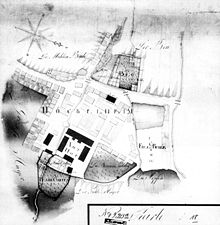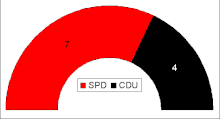Höckelheim
|
Höckelheim
City of Northeim
|
||
|---|---|---|
| Coordinates: 51 ° 42 ′ 2 " N , 9 ° 57 ′ 43" E | ||
| Height : | 119 m | |
| Residents : | 1057 (Jul. 2019) | |
| Incorporation : | July 1, 1970 | |
| Postal code : | 37154 | |
| Area code : | 05551 | |
|
Location of Höckelheim in Lower Saxony |
||
Höckelheim is a district of the city of Northeim in the district of the same name in Lower Saxony . There are 1057 inhabitants in the village.
geography
The place is in the Leinegraben of the Leinebergland , about 2 kilometers west of the Northeimer core city. At a distance of 0.5 km, the Leine flows east past Höckelheim in a northerly direction. The Moore , a tributary of the Leine, flows here. The next big city is Göttingen .
history
Höckelheim was first mentioned in 1016 in a deed of donation from Emperor Heinrich II to the Archdiocese of Paderborn as Hukilhem . The place was probably a domain of the Immedinger at the time , as it is referred to in the document as praedium . Bishop Meinwerk von Paderborn initially left this domain to his mother Adela , but tore it away from her again and handed it over to Emperor Heinrich II, who then bequeathed it to the Paderborn Monastery. At the end of the 11th century, Helmoldus de Huckelem appears for the first time in documents , who owns Allod in Höckelheim. It is assumed that Helmold comes from the Immedinger branch and is to be regarded as the ancestor of the noble lords of Plesse . From 1208 a priest Heinrich is attested in Höckelen , who apparently served the local community as an independent parish with its own church.
In 1247 the Höckelheim monastery was founded in the village . In the first hundred years after its founding, the monastery and town flourished thanks to donations from the monastery donors. It also acquired land and had it cultivated in its own hands, which once belonged to the village, which apparently reduced the size of the Höckelheim field. This ultimately had an impact on the town's population, which gradually decreased. After that, however, the monastery began to gradually deteriorate, which may also have had an impact on the town. In 1534 Dietrich III joined. from the Plesse to the Reformation and took the monastery under its own administration. On October 21, 1545, the battle of the same name between troops of the Schmalkaldic League and imperial troops under the leadership of Hilmar von Münchhausen took place in the area of Höckelheim . In 1571 the village became part of the Landgraviate of Hesse , five years later Superintendent Bartholomaeus Meyer appointed Jacob Eckhardt, the first evangelical preacher in Höckelheim, who subsequently married a previous nun in 1578. In the meantime, Landgrave Wilhelm set up a kind of preacher's widow's fund in Hesse and also included the Höckelheim monastery. In the mid-1580s it was obliged to deliver 140 quarters of grain, 20 quarters of barley and 20 quarters of oats annually to the Höckelheim magistrate Hillebrandt Rhusenn. The monastery intervened and claimed the annual income there, since at that time it had already become an institution for unserved noble ladies and civil servants' widows. The only kind of income was in the benefices who became unmarried after a member of the monastery died. Another problem arose at the end of the 16th century with the Brunswick access to the monastery and the strain on the surrounding Hessian villages. While Erich II the Younger hesitated to take concrete action, his successor, Duke Julius , had his coat of arms posted in the villages of the rule of Plesse in 1584. Due to the refusal, he finally took the monastery with an armed hand. However, several mandates justified the return of the monastery to Hesse in 1587, but not without first having confiscated some goods. Julius prohibited the Plessian villages from delivering any fruit or interest to the monastery. However, the Braunschweiger stuck to their legal claims, only the Göttingen recession of May 2, 1616 and a second one on February 16, 1618 brought calm to the hostile people. However, violent friction flared up again and again during the 17th and 18th centuries.
In 1807 the place was incorporated into the Kingdom of Westphalia and in 1813 it became part of the Kingdom of Hanover . While it was part of Westphalia, Höckelheim was assigned to the canton of Moringen , in the Leinedepartement . At that time, numerous privileges were lost, such as exemption from military service and the waiver of taxes, which increased the financial hardship of the residents. However, the inhabitants suffered greater damage in 1811 from two fires, the first on March 8th and the second on October 18th. The latter fire destroyed the entire village except for seven houses, whereby the church, which served the families as a refuge, was only slightly affected by the flames. The rectory and some monastery buildings were also cremated within the monastery complex. The remaining ground floors were converted into stables and utility buildings. A year later, in 1812, the St. Anne's Chapel was still located in front of the monastery gates on the Annenbüh, but it had also been damaged. A little later it was demolished without removing the associated grave monuments. However, these were sold by the church council in 1833.
On July 1, 1970, the independent community of Höckelheim voluntarily incorporated into the city of Northeim.
On December 3, 1991, the coin find from Northeim-Höckelheim was discovered in Höckelheim during construction work in the street An der Schule . It is considered the most important late medieval coin find in northern Germany.
politics
Local council
The local council in Höckelheim is made up of eleven council members:
The current electoral term runs from November 1, 2011 to October 31, 2016.
Local mayor
Local mayor is Ludwig Binnewies, deputy mayor is Kerstin Hillemann.
coat of arms
Höckelheim has been using the Plessian wall anchor in the local coat of arms since a permit issued in 1948/49 . There is also a tree of life on a blue background with lily-like end flowers in the local coat of arms. The tree symbolizes rural life, the lily, which stands for purity, represents Saint Mary as the patroness of the former Höckelheim nunnery.
Infrastructure
traffic
The Autobahn 7 runs about 2 kilometers west of the village, where Höckelheim can be reached via the Northeim-West junction . The location is directly on the north of Northeim to Moringen extending bundesstraße 241 . The K 421 , which is run as Angerstrasse , leads to Hillerse in the south . Near Höckelheim, the 406 district road branches off from the B 241 northwards to Hollenstedt , about 6 kilometers away .
The Sollingbahn (Ottbergen − Northeim) runs south of the village .
There is a petrol station on federal highway 241, which runs through the village.
education
There is a day care center (crèche and kindergarten) and a primary school.
shop
In the town center there is a bakery with an attached grocery store and DHL parcel shop.
Culture
Club life
The "Höckel'sche Fastnacht" has been celebrated in the village since the times under the Landgraviate of Hesse . The highlight of the festivities is the Rose Monday parade, the only one of its kind in Lower Saxony. So Höckelheim is next to Dassensen , Hilwartshausen , Hohnstedt and Lauenberg a stronghold of the foolish hustle and bustle in the Northeim district . There are other sports at SV Höckelheim.
church
The church of St. Marien was built in 1794 on the site of the monastery I. It is an almost square building to which an extension was added on the east side in 1963. The quarry stone walls of the old building are structured by arched windows set in sandstone and an entrance portal located in the slightly protruding middle section of the west side. The tent roof is crowned by a square ridge turret with the year 1871 on the weather vane. The extension is plastered. The parish of the Marien-Kirche belongs to the parish of Leine-Solling .
Web links
- Website of the village of Höckelheim
- Website of the town of Höckelheim on the website of the city of Northeim
- Local portrait of Höckelheim on the website of the city of Northeim
Individual evidence
- ↑ a b City of Northeim: Höckelheim (as of 07/2019) . Retrieved April 7, 2020.
- ^ Wording of the document in Heinrich II's imperial documents in the MGH
- ^ Wilhelm Cuno: Höckelheim - history of the village and monastery . In: History of South Hanoverian castles and monasteries . tape VIII , 1898, p. 5 .
- ↑ Portrait of the village of Höckelheim in the city of Northeim (accessed on January 13, 2016)
- ^ Federal Statistical Office (ed.): Historical municipality directory for the Federal Republic of Germany. Name, border and key number changes in municipalities, counties and administrative districts from May 27, 1970 to December 31, 1982 . W. Kohlhammer GmbH, Stuttgart and Mainz 1983, ISBN 3-17-003263-1 , p. 213 .
- ↑ http://wahlen.kds.de/2011kw/Daten/155011_000063/index.html
- ^ Tilo Rumann: The noble lords of Plesse and their relationships with Northeim, in: Northeimer Jahrbuch 2003, p. 52f
- ^ Local coat of arms Höckelheim at Heraldry of the World
- ↑ Christian Kämmerer, Peter Ferdinand Lufen: District Northeim, part 1. Southern part with the cities Hardegsen, Moringen, Northeim and Uslar, the spots Bodenfelde and Nörten-Hardenberg, the community Katlenburg-Lindau and the community-free area Solling . Ed .: Christiane Segers-Glocke. CW Niemeyer, Hameln 2002, ISBN 3-8271-8261-1 , p. 292 (Monument topography of the Federal Republic of Germany. Architectural monuments in Lower Saxony, volume = 7.1).





